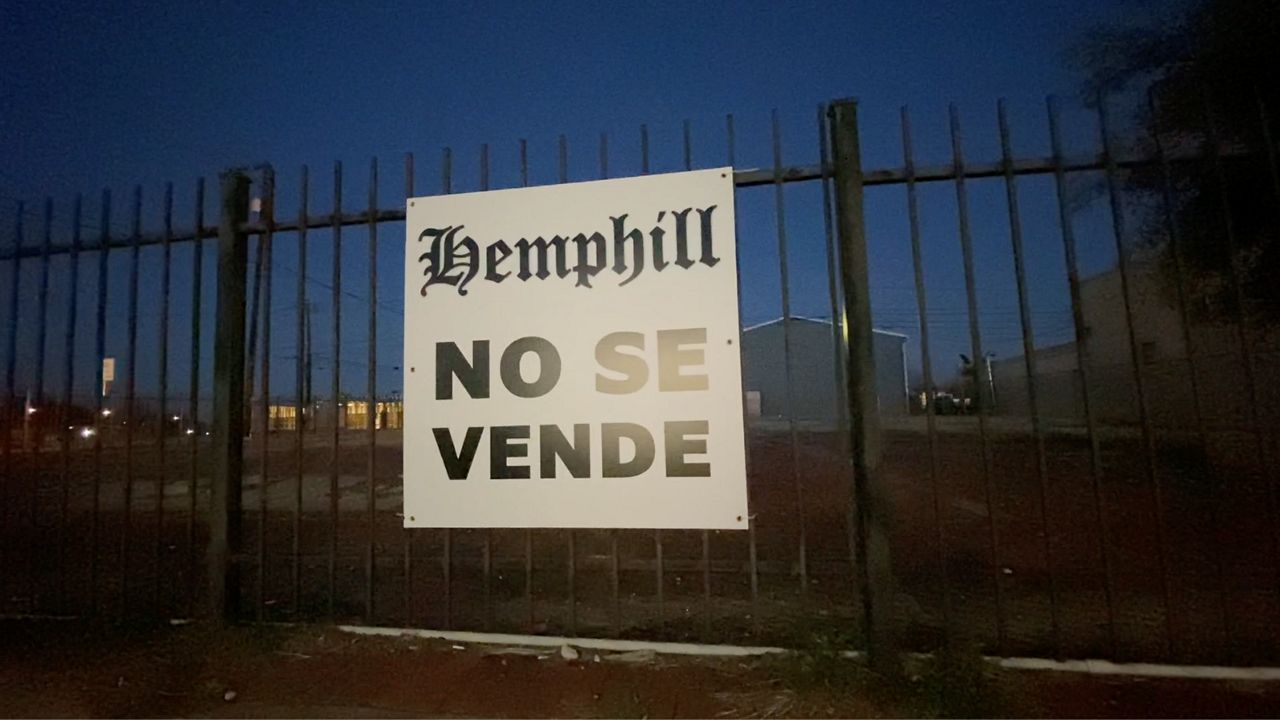FORT WORTH, Texas — A mural that reads “Hemphill No Se Vende,” which translates to “Hemphill is not for sale,” greets southbound traffic on Hemphill Street, a historic, primarily Hispanic area set in the Near Southside of Fort Worth. Just below those words is an image of Emiliano Zapata — the Mexican revolutionary who fought for land ownership rights for peasant farmers in the early 1900s. Artist Juan Velázquez’s work is a symbol of a long-simmering fight over the soul of the neighborhood.
A nearby 11.3-acre plot on the corner of West Biddison Street and South Jennings Avenue has become the center of a larger debate on development, gentrification, and affordable housing. Fort Worth zoning commissioners unanimously voted this month to recommend approval of a zoning change for new housing on that plot.
The proposal for Tobias Place calls for 291 units priced as “workforce housing,” meaning attainable for low-income working families. Proponents of the development say the core-city areas need investment, particularly in housing.
The lot is near the boundaries of several neighborhoods. Its proximity to Hemphill Street has businesses in the area concerned about the development’s effect on traffic and property values. More broadly, many are worried that Hemphill is destined to be the next Magnolia or West 7th, displacing longtime businesses and residents, many of them Hispanic.
Skyrocketing rent forced Rudy Avitia out of his Magnolia Avenue barbershop 10 years ago. He and others see the coming development as a familiar tact to force poor Hispanic residents farther out to the fringes of town.
“Basically, the developers need to come this way because there's no more property to develop [in the Near Southside],” Rudy said. “I'm buying my property, but if I wasn’t, then my rent was going to go up because the taxes are going to go up. They're going to go up on me and everybody else down the road on Hemphill that's been here for forever.”
Proponents of the plan point out the Tobias Place sits on a vacant lot, so no businesses or residents will be displaced. Daniel Smith, vice president of investments for developer Ojala Partners LP, said the apartment complex wouldn’t be adjacent to single-family housing, a common concern for homeowners worried about traffic and noise.
Supporters say Ojala Partners has worked to improve the project. The company consulted with the Worth Heights Neighborhood Association and agreed to a deed restriction to limit the area’s density. Buildings will be no taller than three stories — the original plans called for four. The company heard neighborhood concerns about the complex’s look fitting the history of Worth Heights, Smith said, and the company is looking at adding green space nearby at neighbors’ request.
Even the complex’s name derives from residents’ feedback. It honors Cirildo “Toby” Tobias, a longtime city employee known for his service to the Worth Heights area, especially those he coached in youth sports.
The site is owned by XTO Energy but was never used for gas drilling. However, it may still require environmental attention from past uses, Smith said. If that’s not major work, ground could break on the project in early 2023, and it could be finished by the middle of 2024.
Richard Riccetti heads the Hemphill Corridor Task Force, a coalition of the eight neighborhood groups that occupy the south side of the city. He and the other volunteers on the task force have been working on revitalizing the area for years. They’ve hosted several public meetings about rezoning, shared information with other neighbors and business owners, and have been working toward a goal of turning Hemphill into a safe, viable artery for the neighborhood.
“The goal of the rezoning, oddly enough, is to slow gentrification and build on the character that we have with our Southern neighborhoods,” he said. “In the last 11 years, [house] prices have doubled in Fort worth. So how do we protect our neighborhoods? That is the whole gist of the zoning. That's why I find the misinformation out there just dumbfounding. The role of the zoning is to basically play defense against improper or unwanted development.”
He said the rezoning would be tax-neutral and that the real threat of gentrification comes from private investors who offer cash for homes in the area.
“There's lots of developers that are calling up individual residents, and there's lots of mailers going out,” he said. “ ‘I'll buy your house,’ ‘Your house for cash.’ So there's a lot of outside developers coming in wanting to buy up people's homes. So they're feeling that pressure from their mailboxes.”
The Hemphill No Se Vende group and others who oppose these apartments worry the city is only concerned with development and not the impact they will have on current residents.
“More people also means higher crime and a more congested Hemphill Street, which is already congested as it is with only one lane each way,” a group spokesperson said on social media.
The apartments, she said, “would also overcrowd an already overcrowded Worth Heights Elementary and Rosemont Middle School. Worth Heights is composed of 96% Hispanic students. They are also operating at $3,000 less per student than the average $10,000 through the district. We need more resources at the schools within our community, not more students to take from the little that is given to them already."
"Apartments are not the answer to Southside's issues,” she continued. “We need better lighting, improved streets and infrastructure and more support from our elected officials.
“Before we allow outsiders come into our communities to ‘make it better,’ we need our elected officials to come in and do their job by answering why we keep asking for the same things and nothing happens,” the continued.
The City Council may take up the zoning change within the next couple of weeks.



